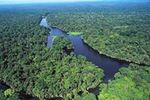The largest island of the West Indies group (equal in area to Pennsylvania), Cuba is also the westernmost—just west of Hispaniola (Haiti and the Dominican Republic), and 90 mi (145 km) south of Key West, Fla., at the entrance to the Gulf of Mexico. The island is mountainous in the southeast and south-central area (Sierra Maestra). It is flat or rolling elsewhere. Cuba also includes numerous smaller islands, islets, and cays. Arawak (or Taino) Indians inhabiting Cuba when Columbus landed on the island in 1492 died from diseases brought by sailors and settlers. By 1511, Spaniards under Diego Velásquez had established settlements. Havana's superb harbor made it a common transit point to and from Spain. In the early 1800s, Cuba's sugarcane industry boomed, requiring massive numbers of black slaves. A simmering independence movement turned into open warfare from 1867 to 1878. Slavery was abolished in 1886. In 1895, the poet José Marti led the struggle that finally ended Spanish rule, thanks largely to U.S. intervention in 1898 after the sinking of the battleship Maine in Havana harbor.
Cuba Travel Guide
Top Destinations in Cuba

Tortuguero National Park, Cuba
Parque Nacional Tortuguero is a protected wilderness area on Costa Rica's northern Caribbean coast. Its beaches are famous nesting grounds for sea turtles, ... more

Baracoa, Cuba
Baracoa is a municipality and city in Guantanamo Province near the eastern tip of Cuba.The remote location at the eastern end of the Cuban island has kept the ... more
